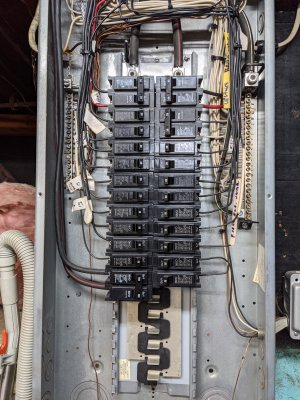- Joined
- Dec 18, 2019
- Messages
- 6,433
Feeling kind of chipper that I figured out most of my electrical needs for my shop, I went to the local electrical supply place and bought stuff. Laying out everything on the bench, I decide to remove the cover to the main panel in the basement. I don't seem to have enough space on the ground and neutral bars to install the 6 additional circuits. (2 120V 20A for machines, 1 120V 20A, 1 220V circuit for temporary heat, 2 120V 15A for lights and a belt grinder.) I can install some of these circuits, (maybe 1/2) but then there is no more room on the bars to add any more. If I added maybe 10-15 more holes, it would be enough.
If I recall correctly one is allowed 2 of the same gauge on ground, and only one wire on neutral. Both bars seem short for the panel size. Is it difficult to extend the bars? What is needed to be done so that it is safe? Are there special jumpers or lugs made for the purpose or just a large appropriately sized wire? Does one need access to the back side of the panel to attach the bars? It would seem one would need back panel access. A quick look didn't reveal any features on the panel that would make this easy except for the pre-drilled bus bar holes in the panel.
What's annoying is that I had an electrician replace our exterior knob & tube wiring and put in a 100A sub-panel for my garage about 10 years ago. Adding the bars would have been relatively easy at that time. I don't remember getting a warning from the electrician that the box was basically full.
Eaton/Cutler-Hammer panel BR4040L200 / CL204040, uses standard BR breakers.

So any advice? Sort of easy DIY? Worst case I have to lift the panel away so I can get in some retaining fastener for the bars? Main disconnect is outside, so this is a warmer day activity. Not scared of electrical work - understand more than the basics, but haven't done this kind of panel activity before. I've worked with much higher voltages in work settings, and understand what not to do. (TWT's, other HV devices)
If I recall correctly one is allowed 2 of the same gauge on ground, and only one wire on neutral. Both bars seem short for the panel size. Is it difficult to extend the bars? What is needed to be done so that it is safe? Are there special jumpers or lugs made for the purpose or just a large appropriately sized wire? Does one need access to the back side of the panel to attach the bars? It would seem one would need back panel access. A quick look didn't reveal any features on the panel that would make this easy except for the pre-drilled bus bar holes in the panel.
What's annoying is that I had an electrician replace our exterior knob & tube wiring and put in a 100A sub-panel for my garage about 10 years ago. Adding the bars would have been relatively easy at that time. I don't remember getting a warning from the electrician that the box was basically full.
Eaton/Cutler-Hammer panel BR4040L200 / CL204040, uses standard BR breakers.

So any advice? Sort of easy DIY? Worst case I have to lift the panel away so I can get in some retaining fastener for the bars? Main disconnect is outside, so this is a warmer day activity. Not scared of electrical work - understand more than the basics, but haven't done this kind of panel activity before. I've worked with much higher voltages in work settings, and understand what not to do. (TWT's, other HV devices)

